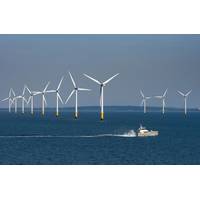Long Beach Port : LEED 'Gold Status' for Conservation Efforts
Four structures at the Port of Long Beach’s newest marine terminal recently earned the coveted “gold” status in the U.S. Green Building Council’s Leadership in Energy and Environmental Design (LEED) rating system, which encourages the use of Earth-friendly features that save energy, conserve water and use recycled materials.
Located at Long Beach Container Terminal’s new Pier E facility at Middle Harbor, the four buildings function as administrative offices and meeting space, an information technology center, and maintenance and operations structures. They range in size from 10,000 square feet to 50,000 square feet and were completed last year in preparation for this spring’s opening of the new terminal.
The LEED awards are for the first phase of the new terminal. The $1.3 billion automated Middle Harbor terminal, nearly all electric and near zero emissions, is being built in two phases, with the second half due for completion in 2020.
As part of the 2005 Green Port Policy, the Long Beach Board of Harbor Commissioners declared that every new major building at the Port of Long Beach would be LEED certified. The approval of the Middle Harbor buildings brings the total number of LEED-certified buildings at the Port to 10, including nine at the gold level and one at the silver level.
“This is truly a milestone for the Port of Long Beach,” said Harbor Commission President Lori Ann Guzmán. “Middle Harbor is the greenest and most technologically advanced terminal in the world. Projects like these prove our commitment to becoming the Green Port of the Future.”
High-efficiency systems reduce power use, save water through low-flow water systems in restrooms, reuse old asphalt and concrete wherever possible and incorporate drought-tolerant landscaping to help reduce runoff and conserve water. Floor vents bring in outside air and allow employees to control their workspace temperature. Exterior features include special parking for fuel-efficient vehicles and solar panels over the parking lots.
The Port worked with engineering consultants AECOM in the design of the Middle Harbor buildings. S.J. Amoroso and W.E. O’Neil were responsible for the construction.
In the four new buildings, water usage was reduced by 40 percent. Energy use was cut in half for lighting and heating, ventilation and air conditioning systems. At least 25 percent of total building materials were composed of recycled content.
The Port of Long Beach is one of the world’s premier seaports, a gateway for trans-Pacific trade and a trailblazer in goods movement and environmental stewardship. With 175 shipping lines connecting Long Beach to 217 seaports, the Port handles $180 billion in trade annually, supporting hundreds of thousands of Southern California jobs.












